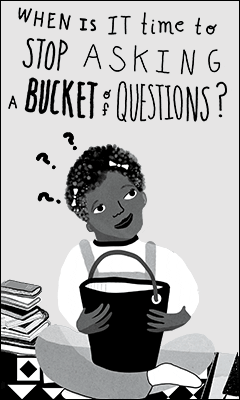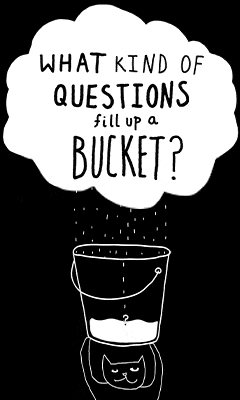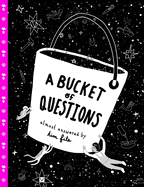A Bucket of Questions
by Tim Fite
Musician, singer-songwriter and multimedia artist Tim Fite breaks into the literary world with a delightful picture book featuring one of his target audience's favorite things: questions! Fite invites young readers to think big and question creatively by showing them firsthand how much fun it can be. The author/illustrator's accompanying art makes this entertaining debut even more delightful.
Fite clearly had fun developing his questions and inventive answer options. Youngsters currently surrendering their baby teeth will surely be eager to guess "Why do kids lose their teeth? A. Kids are untidy. B. Their teeth are soooo tiny. C. To make room for a lucky raisin!" Options A and B appear on the lefthand page of a spread depicting a very messy bedroom (complete with overflowing drawers and mismatched shoes) in which "a lost tooth" is waiting to be found. Option C curves around a giant smiling mouth with a raisin occupying an empty tooth space. Giggles and belly laughs are almost assured as imaginations work at top speed; Fite's questions will likely lead to further inquiry, discussion and discovery. No doubt they will encourage more questions.
The queries run a gamut of subject areas and offer content for a wide range of interests. Budding zoologists may wonder why seals clap, while future art aficionados could ponder why the book is "sooooo" black and white. Charming and somewhat sarcastic comments are sandwiched between questions to further emphasize the silliness of the answer options. For example, after a question about the composition of hot dogs, Fite writes, "These answers aren't even in the ballpark." With wit and ingenuity, Fite offers quiz-style questions that can work as a "test"--no studying required. In A Bucket of Questions, anything goes.
Fite could easily win over fans with the priceless content of his bucket alone, but his striking art is designed to captivate. The dramatic contrast of the black and white is eye-catching; the strong use of line emphasizes the text; and variations in font create a whimsical mood. Fite's distinct and offbeat imagery taps into all the senses. Readers may hear seals clapping at a hermit crab race, taste a hot dog made of "magic and mystery" or feel the wrinkled skin of a loved one--the sensory effect of this book's artwork is a considerable part of its charm.
The author adds an extra element of fun by including a surprise explosion of color. "Why is this book sooooo black and white?" It could be "because my miniature zebra needs somewhere to hide." Or "B. Because all of the colors are sleeping." But C seems like the most probable answer: "Because...... the Rainbow Rooster.../ only sings on page 37." The bold primary colors Fite employs here are energetic--almost psychedelic--and are sure to brighten the faces of readers as they try to comprehend the contrasting patterns and shades of the Rainbow Rooster. Fite then returns to black and white, saying, "Go back to sleep, colors, there are more questions left to (almost) answer." The return to black and white quiets the tone and sets the stage for "Why are old people extra wrinkly?"
Wonderful, small details nestle into the composition of each page and subjects reappear throughout to connect seemingly unrelated questions. (Hot dogs are on the menu at the mermaid barbeque, and teeth float in the bubbles rising from an old woman's bath.) Each page is a veritable hidden picture extravaganza. One such image is a stunning "extra wrinkly" old person with "love" written repeatedly over their face, each "love" representing a wrinkle "for someone they love."
Fite playfully interacts with his readers, treating the book as a link between himself and the child. His desire to encourage questions from young readers shines through with dazzling clarity but, in the event anyone misses it, he spells it out at the end: "Never stop asking a bucket of questions! Just keep filling it with new ones!"
A Bucket of Questions is fresh and fun, amusing and thought-provoking, leaving readers wondering, "How did he ever come up with that?" The inquiries and their unconventional responses create an interactive feel, which gives antsy young readers extra enticement to stay engaged. Sometimes the world discourages people, young and old, from truly scrutinizing their surroundings. Fite goes against that current with strong, exceptional imagery and hilarious text that work together to embolden readers to pursue all possibilities. Fite has raised the bar, and that's a very good thing. --Jen Forbus








